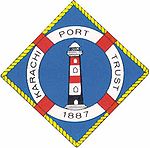
Karachi Port Trust
Encyclopedia

Government of Pakistan
The Government of Pakistan is a federal parliamentary system, with an indirectly-elected President as the Head of State and Commander in Chief of the Pakistani Armed Forces, and an indirectly-elected Prime Minister as the Head of Government. The President’s appointment and term are...
that oversees the operations of the Port of Karachi
Port of Karachi
The Port of Karachi is Pakistan's largest and busiest seaport, handling about 60% of the nation's cargo . It is located between the Karachi towns of Kiamari and Saddar, close to the main business district and several industrial areas. The geographic position of the port places it in close...
in Karachi
Karachi
Karachi is the largest city, main seaport and the main financial centre of Pakistan, as well as the capital of the province of Sindh. The city has an estimated population of 13 to 15 million, while the total metropolitan area has a population of over 18 million...
, Sindh
Sindh
Sindh historically referred to as Ba'ab-ul-Islam , is one of the four provinces of Pakistan and historically is home to the Sindhi people. It is also locally known as the "Mehran". Though Muslims form the largest religious group in Sindh, a good number of Christians, Zoroastrians and Hindus can...
, Pakistan
Pakistan
Pakistan , officially the Islamic Republic of Pakistan is a sovereign state in South Asia. It has a coastline along the Arabian Sea and the Gulf of Oman in the south and is bordered by Afghanistan and Iran in the west, India in the east and China in the far northeast. In the north, Tajikistan...
.
History
Between 1880 and 1887, the port was administered by the Karachi Harbour Board. The Karachi Port Trust was then established by the Act IV of 1886, effective from 1 April 1887.Karachi due to its geographical and strategic location is known as the gateway to Asia. Considered as a safe Harbor since time immemorial, Karachi was a small fishing village in early Nineteenth Century. Historians identify it with its proximity to a place from where a part of Alexander's Army, boarded the Greek Flotilla in 326 B.C.
The first mention of Karachi as a port is found in an Arabic treatise 'Muhit' on navigation relating to the West Coast of India and the Persian Gulf. Written in 1558, this treatise warns the sailors of whirlpools and advises them to seek safety in Karachi Harbor if they found themselves drifting dangerously.
It is also significant to mention that the first Muslim Conqueror of India, Mohammad Bin Qasim, landed at Daibal, in vicinity of Karachi in 711 A.D. Karachi also has the distinction of being the birth place of the founder of Pakistan, Quaid-e-Azam Mohammad Ali Jinnah and was the first capital of Pakistan till 1963. It is now the largest city with a bustling and ever increasing population of over ten million.
By 1852, Karachi was an established city with a population of about 14,000 with a prosperous trade in over-seas markets. However, the existing Port started taking shape in 1854, when the projects of dredging the main navigable channel and the construction of a mole or causeway joining the main harbor with the rest of the city were undertaken. About 5 years later, construction of Manora Breakwater, Keamari Groyne, the Napier Mole Bridge, Native Jetty and the Chinna Creek were started which gave initial shape to the port.
The construction of the wharves started in 1882, and by 1914 the East Wharves and the Napier Mole Boat Wharf had been completed. During the period between 1927 and 1944, the West Wharves of the Port, the lighterage berths and the ship-repairing berths were constructed. Most of these facilities were obsolete by the time Pakistan came into existence in 1947. Since then, the port administration has embarked on extensive development of the port on modern lines.
At the time of independence in 1947, the Port capacity was about 1.5 million tons of dry cargo and 1.0 million tons of P.O.L. products per annum. Karachi Port is now handling over 11.74 million tons of liquid cargo and 25.45 million tons of dry cargo, including 1,213,744 TEUs which constitute about 60% of import/ export of the country.
Administration
The Karachi Port is administered by a Board of Trustees, composed of a Chairman and 10 Trustees. The chairman is appointed by the Federal Government and is also the Chief Executive of the Karachi Port Trust. The remaining 10 Trustees are equally distributed between the public and the private sector. The five public sector Trustees are nominated by the Federal Government. The seats for private sector Trustees are filled by elected representatives of various private sector organizations. This way, all port users can find a representation in the Board of Trustees.Currently the role of chairman has been taken over by Mrs. Nasreen Haque.
Managing Executives
Chairperson
General Manager (Administration)
General Manager (Finance)
General Manager (Operations)
General Manager (Planning & Development)
General Manager (Engineering)
General Manager (Civil Works/Engg.)
Deputy General Manager (Operations)
Secretary, Karachi Port Trust
Heads of Departments
Manager (Management Information Systems)
Traffic Manager
Deputy Conservator
Chief Accounts Officer
Chief Mech. & Elect. Engineer
Manager Finance
Chief Engineer
Chief Internal Auditor
Manager Coordination
Project Manager (Planning)
Project Manager (East)
Project Manager (West)
Project Manager (Mechanical)
Chief Medical Officer
Manager (O&M)
Manager (IR&W)
Manager Stores
Manager (Human Resources)
Manager (Training and Education)
Estate Manager
Commandant Port Security Force
Manager, Pollution Control
Manager Port Safety
Port Intelligence Officer

